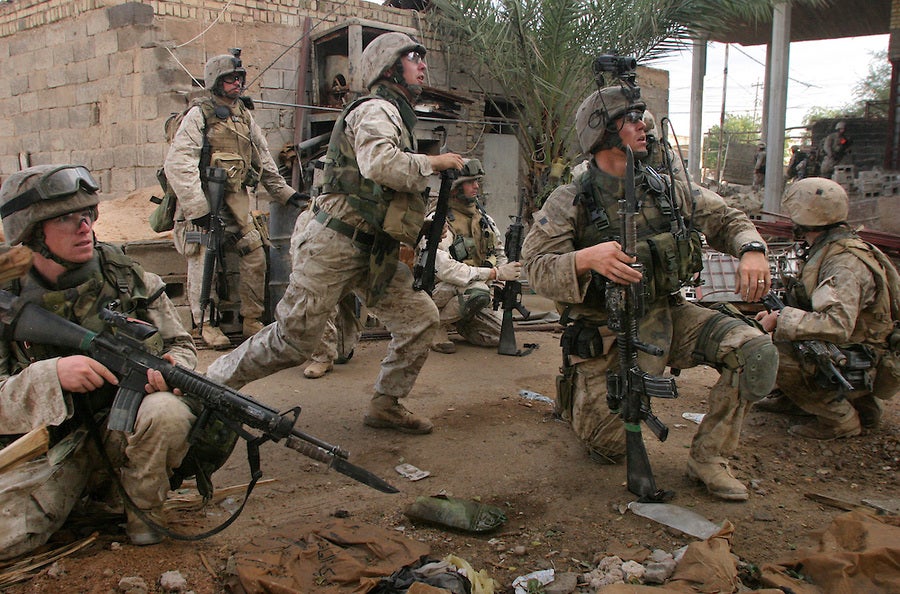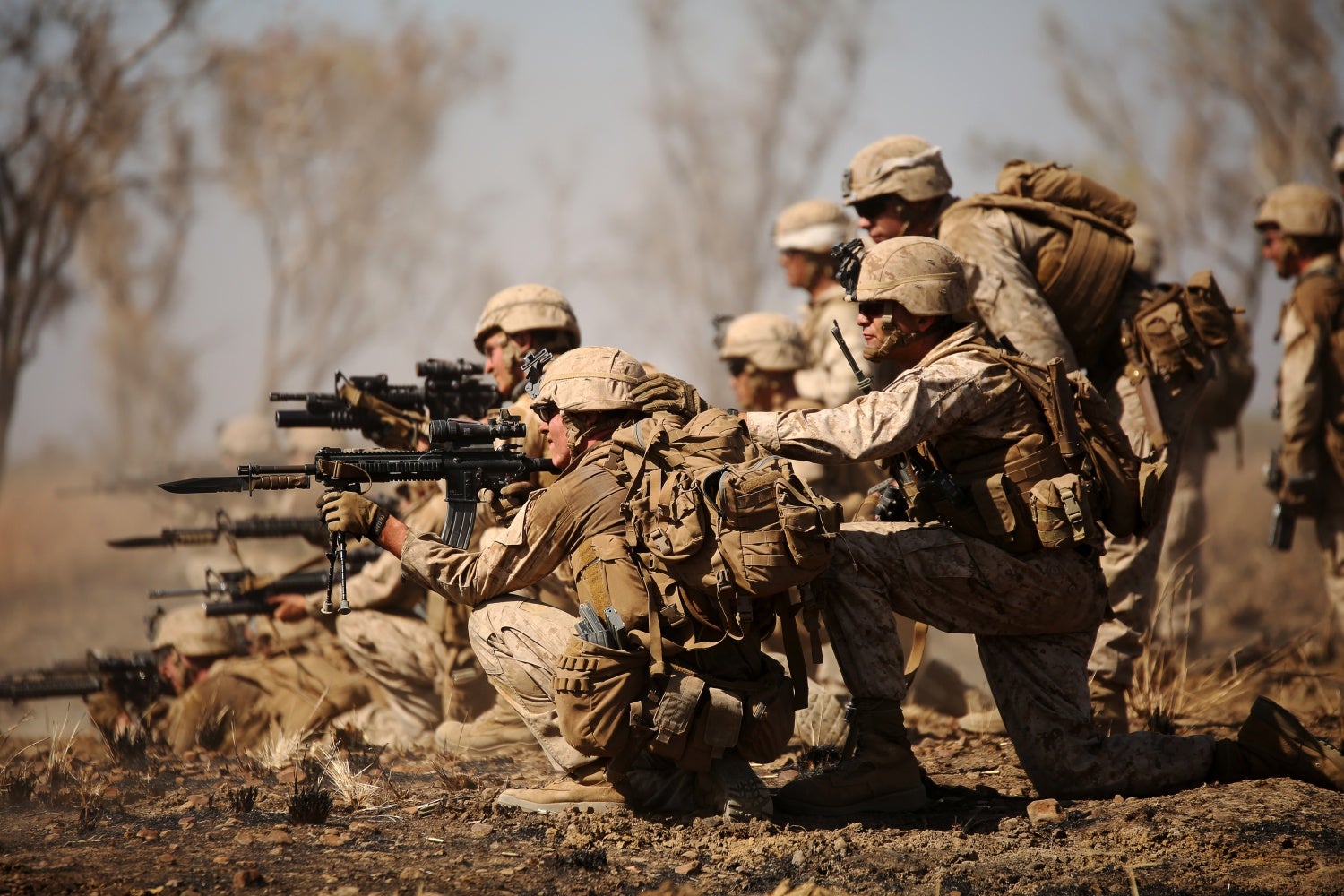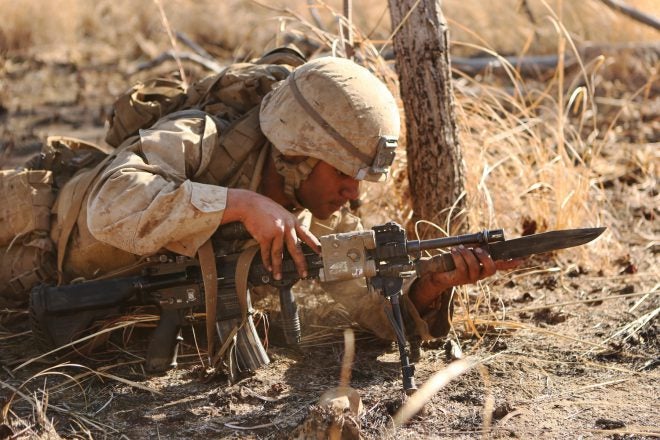The Marine Corps Times (not affiliated with the USMC) released an article detailing the activities of Marine Infantrymen from Bravo Company, 1st Battalion, 1st Marines while undergoing training in the Cultana Training Area of South Australia. Post OIF/OEF, infantry battalions traveling to Australia as part of Marine Rotational Force Darwin, UDPs (Universal Deployment Program) to Okinawa, or the usual MEU (Marine Expeditionary Unit) has become the new routine for the Victor units of the Fleet (active duty infantry battalions). However, with this particular exercise in Australia, I noticed something interesting about the units live fire attack.
Bayonets. Why is that off? Isn’t this supposed to be the bread and butter of any infantry community? Yes, and really no. From a real world vantage unit, of myself serving with 1st Battalion 9th Marines from 2010-2014 as an 0311, the bayonet had completely, literally, and absolutely no tactical/intrinsic or practical value among anything my battalion participated in, whether it was training in the United States or on deployment to Helmand Province. Zero. In fact, guess what happened on deployment? As we drew our weapons at the armory, so too did we draw our bayonets. At the end of the armory line, one of our squad leaders stood with an open seabag (duffel bag), and everyone in the platoon put their bayonets into the bag, a combination lock was locked onto it, and the bag was not opened until we returned to the United States. The only two times I ever affixed a Ontario Knife Company bayonet to my service rifle was once in Boot Camp at Parris Island for bayonet qualification, and then once in the Fleet for some martial arts training that was more the result of a bored Staff NCO giving us something to do than any real world requirement.

Kilo 3/1 Marines in Fallujah 2004. Grunts have their bayonets affixed, and this example is often used as an example of bayonets being used in OIF. However, upon closer examination, this picture was probably taken on the first day of the battle, because if you look at India 3/1’s (Kilo’s sister company) deployment video, you don’t see a single bayonet mounted, in the exact same battle. Thus, this is more reflective of the commanding officer of Kilo ordering his Marines to mount bayonets (it obviously didn’t happen in India), and isn’t reflective of how combat in Fallujah was fought.
Why is this? Is there no need for the bayonet among Marine infantrymen? Granted, President Obama made a comment in one of his speeches about how the military doesn’t use bayonets anymore, and the entire Marine Corps almost had a spiritual seizure. The realistic, bare bones answer is an affirmative “No”, there is no real world requirement for bayonets in today’s warfare. How we fought and patrolled in Helmand and Iraq never presented an opportunity for a bayonet to be affixed and used in combat. There were isolated cases in both areas of operations where bayonets did come in handy when it came to close quarters combat. But for the overwhelming majority of the time that Infantry Marines have been engaged in combat, myself included, we did not utilize bayonets. Where is the tactical necessity to mount a bayonet when your dismounted patrol is getting shot at from 600 meters plus with a PKM? Because of the suicide bomber threat and stricter Rules of Engagement, if anything there has been a push to keep the enemy at a distance, rather than closing with them. On Vehicle Control Points, while engaging civilians in social situations, there has very rarely ever been a threat that could not be solved with a rifle or a handgun better than with a mounted bayonet. Maybe if we ran out of ammunition? That could be a possibility, but then again there has very rarely ever been a U.S. force that has gotten low on ammunition in OIF/OEF and could not have been resupplied.

Check out the M27 gunners drop pouch stuffed full of magazines. These guys get issued 20 magazines for their M27, and sometimes have to carry all of them on these live fires.
Why do we still have them then? The psychological benefit of the bayonet, is one that is extremely hard to replicate with anything else when it comes to closing with the enemy. Dave Grossman covers it very well in his book On Killing. I’ve selected this paragraph from an academic paper on the topic as well–
The rarity of bayonet fighting has long been an established fact. Credible eyewitnesses to battle have frequently observed that soldiers seldom trade blows at close quarters. During the nineteenth century, the experienced Swiss soldier, Baron Antoine de Jomini, was emphatic on this point: ‘I never saw such a thing on a regular field of battle’.9 Ernst Jünger served in the German army throughout the First World War, during which he was wounded seven times and was highly decorated for bravery; and yet it was not until March 1918 that he witnessed a large-scale bout of hand-to-hand fighting.10 According to Fred Majdalany, a British veteran of the Second World War, there was a ‘lot of loose talk about the use of the bayonet. But relatively few soldiers could truthfully say they had stuck a bayonet into a German’.11 The last sizeable bayonet charge by US soldiers occurred in Korea in 1951 and was considered a highly unusual event at the time. Captain Lewis Millet led two platoons in an assault against superior Chinese forces that were dug in on a hillside, inflicting some 30 bayonet casualties in the process.12 Since then, smaller episodes have occurred on an infrequent basis. US troopers employed their bayonets against North Vietnamese soldiers during the battle of Ia Drang in 1965.13 In the Falklands War of 1982, Major John Kiszley led his soldiers in a night-time charge against Argentine positions, bayoneting one of the enemy in the process.14 During the second Battle of Fallujah in 2004, US Marines sometimes used their bayonets to kill insurgents whilst clearing buildings.15 British soldiers also had recourse to the bayonet upon occasion in Afghanistan.16 The overall picture, however, is one of isolated episodes of bayonet combat that are deemed unusual when they occur.
So, looking at these guys in Bravo 1/1 with bayonets mounted on their rifles during a live fire attack, I have several conclusions. The first one is for the junior enlisted, sucks to suck, hopefully no one lost one and the entire company had to police call after the attack looking for a single bayonet. In addition, I hope no one suffered any injury from the mounted knives. But the second one is for the officers of the company conducting the attack. Mounting bayonets wouldn’t have been a decision from the Staff NCOs or the First Sergeant of the company, that was a tactical decision made by the company commander, or even the battalion commander. Personally, I can’t see the logic in this. The decision was probably made along the lines of, “Well, we’ve never used bayonets before, so we should try to make sure the guys can know how to use them now during this live fire”. I think the biggest fallacy with this train of tactical thinking, is that the only real world use of the bayonet, would be an attack that gets the infantry within close quarters fighting distance of an enemy. If that isn’t the case, for example with many Marine live fire attacks that often take place over hundreds of meters (IPBC in Fort Pickett is almost a mile long, Range 400 in 29 Palms is about that as well), then this is essentially training to fail. If an attack is taking place over 600 meters to an enemy objective, then there is absolutely no need to fix bayonets the first 500 meters! Training otherwise is counter-intuitive.
The end state of this post is that there are much more important tasks completely relevant to the Infantry skill set than running an attack with bayonets. Such as individual actions, Combat Lifesaver knowledge, Immediate action drills, call for fire, 9 line Medevac recitations, even MCMAP martial arts training that involves wrestling and boxing.
 Your Privacy Choices
Your Privacy Choices
